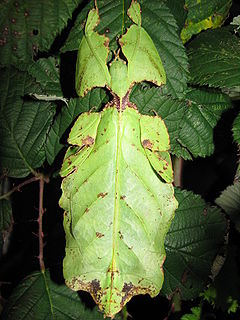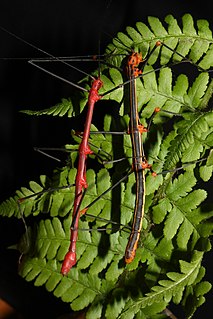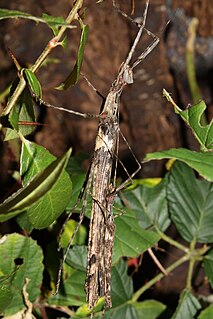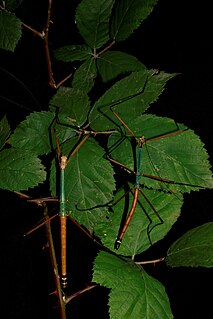
The Phasmatodea are an order of insects whose members are variously known as stick insects, stick-bugs, walking sticks, or bug sticks. They are generally referred to as phasmatodeans, phasmids, or ghost insects. Phasmids in the family Phylliidae are called leaf insects, leaf-bugs, walking leaves, or bug leaves. The group's name is derived from the Ancient Greek φάσμα phasma, meaning an apparition or phantom, referring to their resemblance to vegetation while in fact being animals. Their natural camouflage makes them difficult for predators to detect; still, many species have one of several secondary lines of defence in the form of startle displays, spines or toxic secretions. Stick insects from the genera Phryganistria, Ctenomorpha, and Phobaeticus includes the world's longest insects.

The Verophasmatodea suborder of the Phasmatodea contains the vast majority of the extant species of stick and leaf insects.

The Phasmatidae are a family of the stick insects. They belong to the superfamily Anareolatae of suborder Verophasmatodea.

Diapheromeridae is a family of stick insects. They belong to the superfamily Anareolatae of suborder Verophasmatodea.

Necrosciinae is a subfamily of the stick insect family Lonchodidae, with its greatest diversity in South-East Asia.

Phyllium giganteum, commonly known as the Giant Malaysian Leaf insect, is a species of leaf-insect described from Malaysia by Hausleithner in 1984 and placed in the genus Phyllium and family Phylliidae. Phyllium giganteum are the largest species belonging to the genus Phyllium reaching 105mm in size. They are found most abundantly in the west Malaysian tropics. The females typically have large elytra that lie edge to edge on the abdomen and tend to lack hind wings making them usually flightless. Males have small elytra and sometimes transparent non-leaflike functional hind wings. Phyllium giganteum found in the wild tend to be mostly females and the first male of this species was not found until 1994. The species has the ability to reproduce through parthenogenesis meaning the females are asexual. The primary reproductive pattern in the wild is unknown however in captivity, the females reproduce primary through parthenogenesis. Eggs tend to be brown or black and glossy and resemble the look of seeds. They hatch around 6 months after breeding. Newly hatched young nymphs tend to be wingless and brown or reddish in color. They develop their green color after feeding on leaves. Both the adult and larval stages are phytophagous meaning they feed on plants. The main plant food sources for this species are oak and bramble tree leaves.

Diapheromerinae is a subfamily of the stick insect family Diapheromeridae. They belong to the superfamily Anareolatae of suborder Verophasmatodea.

Bactrododema is a genus of the stick insect family Diapheromeridae. Species of this genus have a relictual distribution and are endemic to southern Africa.

Diapheromera arizonensis, the Arizona walkingstick, is a species of walkingstick in the family Diapheromeridae. It is found in North America.

Diapheromera is a genus of stick insects in the family Diapheromeridae. There are about 14 described species in Diapheromera.

Heteronemiidae is a family of walkingsticks in the order Phasmatodea. There are about 14 genera and at least 80 described species in Heteronemiidae.

Aschiphasmatidae are a family of stick insects belonging to the suborder Verophasmatodea; they can be found in Indomalaya.

Diapheromerini is a tribe of walkingsticks in the family Diapheromeridae. There are at least 30 genera Diapheromerini.
Damasippoididae is a family of walkingsticks in the order Phasmatodea. There are at least two genera and about six described species in Damasippoididae, found in Madagascar.

Trachythorax is an Asian genus of stick insects in the family Diapheromeridae and subfamily Necrosciinae. Species have been recorded from the Indian subcontinent, Indo-China, Malesia through to New Guinea.

Lopaphus is an Asian genus of stick insects in the family Diapheromeridae and subfamily Necrosciinae. Species have been recorded from India, China and South-East Asia.

Pachymorphinae is a subfamily of stick insects in the family Diapheromeridae. Genera are primarily found in Africa, Asia and Australia.

The Lonchodinae are a subfamily of stick insects in the family Lonchodidae found in: Australasia, Asia, Africa, Southern America and the Pacific.

Neoclides is an Asian genus of stick insects in the family Diapheromeridae, subfamily Necrosciinae. Species have a known distribution from: Indo-China, Borneo, Sumatra, Philippines and New Guinea.

The Megacraniinae are an anareolate subfamily of stick insects in the family Phasmatidae. Their known distribution includes Malesia and islands in the Pacific and Indian oceans. Several genera have been revised and were placed previously in the Platycraninae.


















